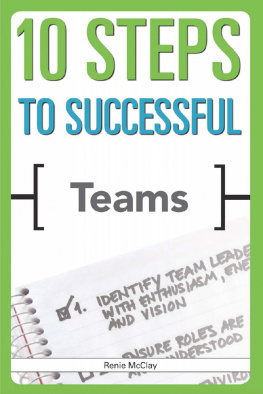The Harvard Business Essentials series is designed to provide comprehensive advice, personal coaching, background information, and guidance on the most relevant topics in business. Drawing on rich content from Harvard Business School Publishing and other sources, these concise guides are carefully crafted to provide a highly practical resource for readers with all levels of experience. To assure quality and accuracy, each volume is closely reviewed by a specialized content adviser from a world-class business school. Whether you are a new manager interested in expanding your skills or an experienced executive looking for a personal resource, these solution-oriented books offer reliable answers at your fingertips.
Other books in the series:
Finance for Managers
Hiring and Keeping the Best People
Managing Change and Transition
Negotiation
Business Communication
Managing Creativity and Innovation
Managing Projects Large and Small
Managers Toolkit
Creating Teams with an Edge
The Complete Skill Set to Build Powerful and Influential Teams
Harvard Business Review Press
Copyright 2004 Harvard Business School Publishing Corporation
All rights reserved
Printed in the United States of America
08 07 06 05 04 5 4 3 2 1
No part of this publication may be reproduced, stored in or introduced into a retrieval system, or transmitted, in any form, or by any means (electronic, mechanical, photocopying, recording, or otherwise), without the prior permission of the publisher. Requests for permission should be directed to permissions@hbsp.harvard.edu, or mailed to Permissions, Harvard Business School Publishing, 60 Harvard Way, Boston, Massachusetts 02163.
Library of Congress Cataloging-in-Publication Data
Harvard business essentials : creating teams with an edge : the complete skill set to build powerful and influential teams. p. cm.(The Harvard business essentials series)
9781422131794
1. Teams in the workplace. I. Title: Creating
teams with an edge. II. Series.
HD66.H3763 2004
658.4022dc22
2003019405
The paper used in this publication meets the requirements of the American
National Standard for Permanence of Paper for Publications and
Documents in Libraries and Archives Z39.48-1992.
Introduction
The Apollo team put the first man on the moon. The first personal computersboth the Mac and the IBMwere the creations of small teams. Ford Motor Company was saved from serious decline around 1980 by Team Taurus, whose newly designed passenger car became the bestseller in North America.
Teams are responsible for many of todays accomplishments. In the business world, they have become commonplace and even fashionableso much so that some people mistakenly believe that the team approach to attacking problems or opportunities is just another management fad. Its not. Team-based work is far from new and its here to stay. For example, when the United States rebellious Continental Congress decided that it needed to produce a declaration of its independence from Great Britain, it created a team to handle the job. That team included two future presidents: John Adams of Massachusetts and Thomas Jefferson, a young Virginian with word-smithing talents. Pennsylvanias Benjamin Franklin provided some editing. Years later, when then-President Thomas Jefferson wanted to understand the half-continent he had acquired from Napoleon through the Louisiana Purchase, he didnt assign the job to a single individual, to one of his government departments, or to a unit of the regular army. Instead he gave the chore to a thirty-two-man team he called the Corps of Discovery. How that task was sponsored, staffed, organized, and led provides a useful example of what teams in any endeavor need to be successful.
As sponsor of the venture, Jefferson placed leadership in the hands of an army captain in whom he had substantial trust, a twenty-nine-year-old Virginian named Meriwether Lewis. Jefferson did two other things at the outset. First, he explained what he wanted: to explore the Missouri River and whichever of its tributaries would reach to the Pacific Ocean. Finding a water route across the uncharted regions of the northwest would be of incalculable value to the new republicreducing the costs and perils of shipping, and opening the newly acquired territory to settlement. Jefferson also wanted detailed information about the land that lay west of the Mississippi River, its flora and fauna, and its native tribes.
Second, as the team sponsor, Jefferson scraped up the money and other resources Lewis would need to get the job done. He got the Congress to appropriate cash over the objections of many naysayers who condemned the venture as a hare-brained idea. Jefferson also provided Lewis with the authority to recruit the people he needed to complete the mission.
Having established the teams higher ends and supported it with resources, Jefferson left the means to Lewis. In addition to assembling the team, Lewis chose the set of skills that he would need on his team, the specific provisions and equipment that would be carried, and the route that the team would follow.
In picking his team, Lewis brought together people with complementary skills: frontier-hardened soldiers who had demonstrated their resourcefulness and ability to live in the wilderness; experienced hunters whose foraging abilities would be needed to supplement the provisions brought from the East; and river men familiar with the first leg of the journey up the Missouri. Lewis also enlisted a coleader, William Clark, whose wilderness know-how, experience with Indians, and qualities of leadership he respected and trusted.
Lewis bolstered his own capabilities through special training. At Jeffersons direction, he traveled to Philadelphia, where he spent several months learning medical procedures from Dr. Benjamin Rush. Benjamin Smith Barton, the leading natural scientist in the Americas, taught Lewis the latest scientific methods of observing plant and animal life, preserving specimens, and recording and classifying findings. The team leader also learned to use a sextant and chronometera skill the team would require in determining and recording its position along the route.
Like many successful teams, the Corps of Discovery added and offloaded members as circumstances required. After the first leg of the journey, for example, the river men, who had little left to contribute, were sent home with scientific specimens and Lewiss progress report to Jefferson. And new capabilities were recruited as needed. Recognizing its deficiency in language skills, the team recruited a French-Canadian frontier trader named Charbonneau who lived among the Mandan tribe. Charbonneau spoke the tribes language. Better still, his wife, Sacagawea, a Hidatsa woman, spoke the language of native people whom the Corps would encounter as it moved west.
The explorers long trek to the Pacific coastand backrequired many on-the-spot decisions. Which branch of the river should they take? How should they deal with the tribal chieftains they encountered ? Where and when should they hunker down for the long winter? Far from home and out of communication with its sponsor, the team could not defer to a higher authority but had to make its own decisions. Since the Corps was a military unit, its officers, Lewis and Clark, made most of the decisions. But other choices were put to the team as a whole. In all cases, the missions goal guided their decisions.







